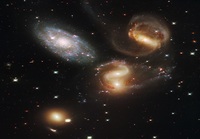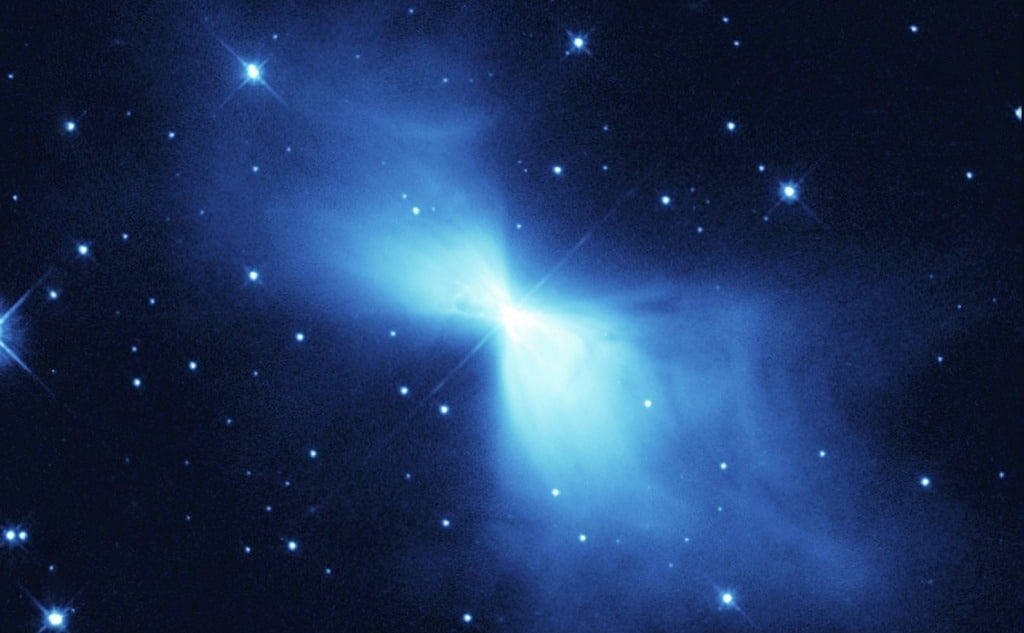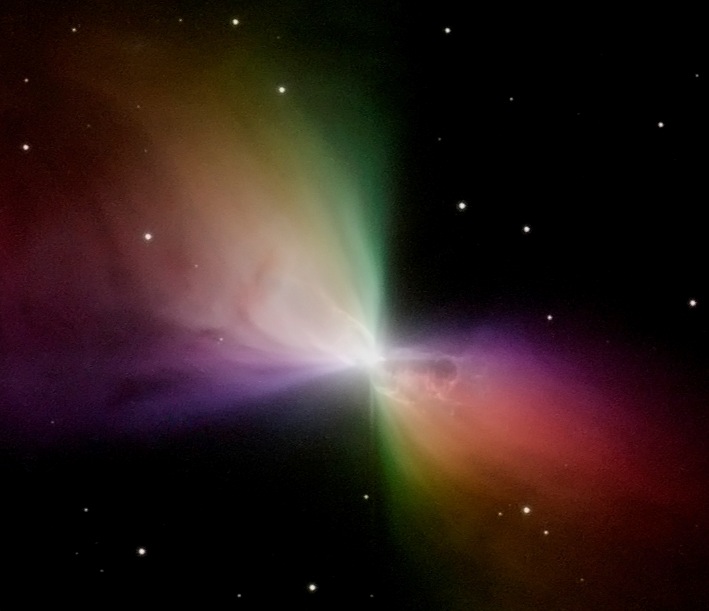

Unable to view it with great clarity, the astronomers saw merely a slight asymmetry in the nebula's lobes suggesting a curved shape like a boomerang. Keith Taylor and Mike Scarrott called it the "Boomerang Nebula" in 1980 after observing it with the Anglo-Australian telescope at the Siding Spring Observatory. The outflowing gas is moving outwards at a speed of about 164 km/s and expanding rapidly as it moves out into space this gas expansion results in the nebula's unusually low temperature. Millimeter scale dust grains mask portions of the nebula's center so most escaping visible light is in two opposing lobes forming a distinctive hourglass shape as viewed from Earth. It continues to form and develop due to the outflow of gas from its core where a star in its late stage life sheds mass and emits starlight illuminating dust in the nebula. The Boomerang Nebula is believed to be a star system evolving toward the planetary nebula phase. The nebula's temperature is measured at 1 K (−272.15 ☌ −457.87 ☏) making it the coolest natural place currently known in the Universe. It is also known as the Bow Tie Nebula and catalogued as LEDA 3074547. The Boomerang Nebula is a protoplanetary nebula located 5,000 light-years away from Earth in the constellation Centaurus. Stunning posters featuring images from the Hubble Space Telescope and world-renowned astrophotographer David Malin are now available from the Astronomy Now Store.The Boomerang Nebula, as taken by Hubble Space Telescope in 2003Ĭentaurus Bipolar Nebula, ESO 172-7, 2MASS J12444609-5431133, LEDA 3074547 NEW! This remarkable calendar features stunning images of planets, stars, gaseous nebulae, and galaxies captured by NASA's orbiting Hubble Space Telescope�.�� The Hubble Space Telescope project is an international cooperation between ESA and NASA. The light in the image comes from starlight from the central star The image was exposed for 1000 seconds through a green-yellow filter. The rapidĮxpansion of the nebula has enabled it to become the coldest known This is 10-100 times more than in other similar objects. One-thousandth of a solar mass of material per year for 1500 years.

The general bow-tie shape of the Boomerang appears to have been createdīy a very fierce 500 000 kilometre-per-hour wind blowing ultracold gasĪway from the dying central star.

However, the Boomerang Nebula is so young that it may not have had time Normally have lobes that look more like "bubbles" blown in the gas. It quite different from other observed planetary nebulae, which The diffuse bow-tie shape of this nebula makes Ghostly filaments embedded within the diffuse gas of the nebula's The Hubble telescope took this image in 1998. "the Bow tie Nebula" would perhaps have been a better name. The high-resolution Hubble images indicate that Saw merely a slight asymmetry in the nebula's lobes suggesting a curved Unable to see the detail that only Hubble can reveal, the astronomers Keith Taylor and Mike Scarrott called it the Boomerang Nebula in 1980Īfter observing it with a large ground-based telescope in Australia. Temperature lower than the background radiation. It is the only object found so far that has a Even the -270 degrees C background glow from the Big Bang is With a temperature of -272 degrees C, it is only 1ĭegree warmer than absolute zero (the lowest limit for all Using the 15-metre Swedish ESO Submillimetre Telescope in Chile,Īstronomers Sahai and Nyman revealed that it is the coldest place in The Boomerang Nebula is one of the Universe's peculiar places. Nebulae form around a bright, central star when it expels gas in the It is in theĬonstellation of Centaurus, 5000 light-years from Earth. Nebula known (rather curiously) as the Boomerang Nebula. This NASA/ESA Hubble Space Telescope image shows a young planetary Trauger (Jet Propulsion Laboratory, United States) and the WFPC2 Science Team. The original Hubble image was obtained by R. Spaceflight Now | Breaking News | Boomerang Nebula - the coolest place in the Universe?īoomerang Nebula - the coolest place in the Universe?


 0 kommentar(er)
0 kommentar(er)
